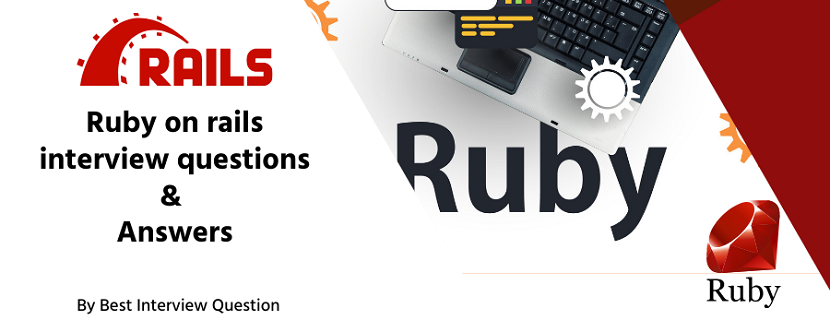Ruby on rails interview questions and Answers

Ruby on Rails is an open-source web development tool that is built on top of Ruby programming language. Designed around productivity and simplicity, this framework gives developers a structure for writing code for building websites and web applications. Ruby on Rails is interpreted like Python, Perl, Tcl/TK, and is object-oriented like Eiffel, Smalltalk, Ada, and Java. If you have read our Ruby On Rails Interview Questions, you can easily find your next dream job.
Most Frequently Asked Ruby on rails interview questions
It is the ORM layer that is supplied with Rails and it follows the ORM model as follows:
- Map Table to classes
- Map Rows to objects
- Map Columns to object attributes
Ajax-powered pages retrieve the page from the server. This page is unlike other web pages where you have to refresh the page to see the latest update. Rails trigger Ajax in the following ways:
- When a user clicks a button, he or she induces changes in the form or field.
- A Java-script method sends trigger-linked data to a handler on the server.
- The server-side handler works on the data and retrieves an HTML to the web client.
- The client-side JavaScript receives the HTML and updates the current.
Use the following command for creating a controller:
C:\ruby\library> ruby script/generate controller subject
The Rails controller is the center of the application that facilitates the interaction between users, views, and model. It also routes external requests to internal actions and handles URL. It also regulates helper modules and sessions.
Rails Migration enables to make changes to the database, allowing it to use a version control system for synchronizing things with actual code. It can perform the following functions:
- Create, drop, rename table
- Add, rename, change and remove a column
self.up is used for migrating to a new version, while self.down is used to roll back changes.
It is a form of attack where a hacker submits a request on your behalf to a website, causing damage or revealing sensitive data. In order to protect from attacks, you must add “protect_from_forgery” to your ApplicationController. This will require a CSRF token to process the request.
You can run your application by uncommenting in environment.rb
path=> rootpath conf/environment.rb
config.frameworks = [ action_web_service, :action_mailer, :active_record]
Observers are the same as Callback, but they are used when the method is not directly associated with the object. The observer lives longer, and can be detached or attached at any time.
Callbacks are methods that can be called only at certain moments of an object’s lifecycle. Callbacks live shorter.
It is a Ruby Make or a utility that is used for administrative tasks such as migrating the database through scripts and loading schema into the database. In Rails, it substitutes the Unix utility ‘make’ and uses ‘Rakefile’ and ‘.rake files’ to build up task lists.
Dynamic Scaffolding
- Automatically creates content and UI at runtime.
- Facilitates the generation of new, delete, and edit methods in the application.
- Does not require the database to be synchronized.
Static Scaffolding
- Requires manual entry to create data within fields.
- Does not require a generation to take place.
- Requires database to be migrated.
Development History
David Heinemeier Hansson released Ruby on Rails in 2004. Even today David is working on Rails with a massive group of open-source contributors to make it faster and better. Before you head for your next interview, have a look at these Ruby On Rails Interview Questions.
Advantages
- Integrated application
- Default configuration saves a lot of time and work.
- Great ecosystem helps you find online tools & support.
- Active development status keeps introducing fixes & adding features.
- Testing frameworks are strong.
Latest Version: Latest version is 6.0.0.rc1, which was released in April 24, 2019. Do summarize this information if you are looking for Ruby Programming Language Interview Questions